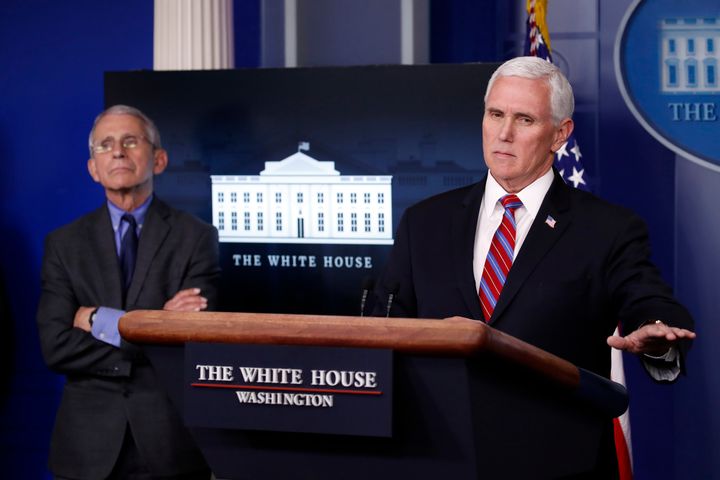Vice President Mike Pence painted a rosy ― and misleading ― portrait of the U.S. government’s response to the coronavirus and the current state of the crisis in an op-ed published Tuesday in The Wall Street Journal.
In one section, Pence, whom President Donald Trump appointed in late February to lead the White House’s coronavirus task force, praised all 50 states for beginning to reopen in a “safe and responsible manner.”
But Dr. Anthony Fauci, the lead infectious disease expert on the task force, suggested that isn’t the case during an interview with NPR earlier Tuesday.
“There certainly were states that did not strictly follow the guidelines that we put out about opening America again,” Fauci said. “There were rather well-delineated gateway criteria followed by phase 1, phase 2 and phase 3.”
He added: “Clearly there were states that ― left to their own decision about that ― went ahead and opened to a varying degree ... certainly before they got to the benchmarks that they needed to get.”
The contradicting statements serve as an example of the distance between the propaganda pushed by the White House and some of the warnings raised by Fauci and other public health experts.
In his nearly 800-word piece, Pence accused the press of “fear mongering” in its coverage of the pandemic and dubbed the nation’s response to the virus “a success.”
“We’ve slowed the spread, we’ve cared for the most vulnerable, we’ve saved lives, and we’ve created a solid foundation for whatever challenges we may face in the future,” the vice president wrote. “That’s a cause for celebration, not the media’s fear mongering.”
In fact, the U.S. has had more documented COVID-19 cases and deaths than any country in the world, despite having less than 5% of the global population. More than 2.1 million people have tested positive for the virus nationwide and over 116,000 have died.
Trump initially downplayed the threat of the virus as scientists warned that it would surely spread across the country with devastating consequences.
During a campaign rally in late February, two days after a Centers for Disease Control and Prevention official sounded the alarm about the virus’s potential impact, the president accused the press of being in “hysteria mode.”
“So far we have lost nobody to coronavirus in the United States. Nobody,” Trump said. “It doesn’t mean we won’t. But think of it ... we’ve lost nobody, and you wonder, the press is in hysteria mode.”
Researchers at Columbia University estimated last month that about 36,000 fewer people would have died of the virus if the U.S. had imposed social distancing measures one week earlier than it did in March.

Pence on Tuesday accused the media of trying to “scare” the American people about a potential second wave of the virus.
“Such panic is overblown,” he wrote. “Thanks to the leadership of President Trump and the courage and compassion of the American people, our public health system is far stronger than it was four months ago, and we are winning the fight against the invisible enemy.”
At least 21 states saw an increase in their average daily new coronavirus cases last week compared to the week before, reported The Washington Post. On Tuesday, Texas Gov. Greg Abbott (R) urged people to stay home as the state recorded its highest number of new COVID-19 hospitalizations yet.
While Fauci has said a so-called second wave of the virus isn’t “inevitable” if guidelines are followed, he’s also acknowledged that the crisis is far from over.
“We’re seeing several states, as they try to reopen and get back to normal, starting to see early indications [that] infections are higher than previously,” Fauci told The Telegraph last week.
The virus “could go on for a couple of cycles, coming back and forth,” he added. “I would hope to get to some degree of real normality within a year or so. But I don’t think it’s this winter or fall, we’ll be seeing it for a bit more.”
Social distancing and wearing masks are key to curbing the contagion, Fauci and so many other scientists and medical professionals have stated over and over again.
Pence, who has been photographed many times doing neither in situations that call for both, lauded the president for having “rallied the American people to embrace social-distancing guidelines.”
Trump, of course, often undermines his own guidelines on social distancing. He’s been seen numerous times in public without a mask surrounded by other administration officials who aren’t wearing masks. He voiced support for anti-lockdown protesters who stood side-by-side without masks to demand their states reopen despite not meeting federal guidelines for doing so.
Perhaps Trump’s most brazen disregard for his own administration’s guidelines is the rally his campaign has scheduled for Saturday at a 19,000-seat arena in Tulsa, Oklahoma ― an event one health expert called “extremely dangerous.”
In recognition of the risk, the Trump campaign posted waiver language on its registration website requiring all attendees to agree not to sue Trump if they contract the virus at the rally.
Tulsa City-County Health Department Director Bruce Dart said Sunday that the rally poses a “huge risk” for the region. He said he wished Trump would postpone it.
“I’m concerned about our ability to protect anyone who attends a large, indoor event,” Dart said, “and I’m also concerned about our ability to ensure the president stays safe as well.”
- Stay up to date with our live blog as we cover the COVID-19 pandemic
- 7 essential pieces of relationship advice for couples in quarantine
- What you need to know about face masks right now
- How to tell if you need to start doing online therapy
- Lost your job due to coronavirus? Here’s what you need to know.
- Parenting during the coronavirus crisis?
- The HuffPost guide to working from home
- What coronavirus questions are on your mind right now? We want to help you find answers.
- Everyone deserves accurate information about COVID-19. Support journalism without a paywall — and keep it free for everyone — by becoming a HuffPost member today.

